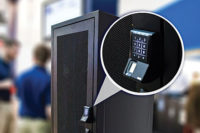While access control likely trails only video on the excitement and energy scale when it comes to products within the security industry, two components of that segment — entry controls and intercoms — most likely rank very low, if at all.
That may be about to change, however, as two of the industry’s biggest concepts (and buzzwords) — network and integration — creep into the entry control and intercom space. In other words, these aren’t your parents’ technologies. Not by a long shot. And if a number of manufacturers’ forecasts are to be believed, we’re going to be looking at a very different set of products and technologies in the not-so-distant future.
Despite their lower profile, entry controls and intercoms are integral to maintaining security for end users and also present an excellent opportunity for dealers and integrators, says Bradley Kamcheff, senior marketing specialist, Aiphone, located in Bellevue, Wash. Once a door is opened, the security of an entire building is breached, says Kamcheff, adding that “wherever there’s a locked door, there’s a need for an intercom.”
“We’re seeing continued growth across all market sectors,” he says. “For the customer, an intercom should be the first thing a visitor encounters when they reach a secured door. They allow those on the secured side to stay safe while giving assistance to visitors with a legitimate need to enter. And for the installer, an intercom is a perfect way to add appropriate revenue to a smaller job.”
Bringing it all Together
One of the biggest game-changers in recent years for entry controls and intercoms is the ability to tie in additional systems and technologies to create a more robust offering that operates as an integral part of an overall security solution. This has made each a larger part of the overall conversation, says Gary Baker, vice president of marketing for Carlsbad, Calif.-based Linear, LLC.
“The market is stronger, especially with entry control,” he says. “Things have progressed to where systems are starting to communicate with each other and they’re starting to communicate with handheld devices and they’re able to communicate within a home or office.”
Given its prevalence and overall position in the security industry as a whole, it’s not surprising that video has been the most in-demand integration for door controls and intercoms. Kamcheff says the time was right for this combination, particularly because the maturity of the technologies has made the integration much less troublesome.
“Most intercoms and door entry systems can be integrated easily with CCTV and access control,” he says. “Integration can be as simple as supplying a switch closure to cause a strike to activate something, or as complex as API integration, allowing systems to perform communication and pass functions. Ease of integration just depends on the comfort level of the person performing the integration.”
It’s a far cry from “the old days” when combining an intercom or entry controls with video was much more difficult, says Richard Sedivy, director of marketing and regulatory affairs, DoorKing, Inglewood, Calif. Although, he adds, despite their seeming coziness, the two remain distinct entities from one another.
“Historically, audio was going over one path and video over another. For an entry system, you’d have a couple wires that would carry the audio signal and you’d have a coax that would carry the video signal back to a monitor,” he says. “All that’s changing now. They’re still two separate signals, but these days we’re able to transmit those two signals over the same pathway. We don’t need wires for audio and coax for video, especially when you do it wirelessly. Now we can simply send the data — both audio and video – back to where it’s captured, and people can use their phones or their cell phones, whatever the case may be, to speak to the visitor. And at the same time, they can look at a monitor in their home — their computer monitor and in some cases they can pick up their cell phone and take a look at the video on their cell phone to see who’s out there.
“In a sense it’s very integrated, but they’re still two different animals. We’re just sending it all down the same pipeline nowadays,” he adds.
For most people, the desire for a video-enabled entry or intercom system comes from the simple fact that they want to be secure, and being able to verify that the person who’s at the door or the gate is who they say they are before letting them in provides that much more security, Baker says.
“It used to be you’d press a button and ask, ‘Who’s there?’ Now with video, this really takes the industry by storm because you can actually see who’s at the front door,” he says.
Wires Optional
A previous barrier to selling and installing these systems was the need to install dedicated phone lines for an intercom or entry control system. If video were involved, that meant a corresponding coaxial cable had to be in the mix as well. Labor costs drive up overall installation costs — and, by extension, the cost of overall systems — and that’s not exactly the best model for door entry and intercom systems.
But this is the 21st century. And while we’re all still waiting for those flying cars we were promised, we do have the advantage of living in a world where wires are, for the most part, optional.
“Right now, the biggest thing is that we’re seeing more wireless devices. Wireless intercoms have been around for several years, but what we’re seeing now are wireless telephone intercoms,” Sedivy says. “They interface with the telephones inside, except now we can do this wirelessly also. In our case, that’s where we see some of this market going.”
The main drawback to wireless systems, Sedivy says, is that they tend to be a bit more pricy than their wired cousins. And while that’s true from a pure “price tag” perspective, when you factor in the aforementioned installation costs, wireless can be much more cost-effective.
“The gain is that you don’t have to dig a trench from point A to point B, so the instant savings in not having to dig that trench exceed the cost of a wireless solution,” he says. “A lot of times, you’re better off going wireless, and a lot of people are starting to understand that and see that.”
Wireless may be the wave of the future for entry control and intercoms, but Sedivy cautions installers and integrators not to forget about the basics when planning and installing them.
“A lot of these wireless systems are line of sight. They go a fair distance — we’ve got systems that go up to a mile, but it’s still line of sight transmission, so you have to be aware of some limitations on these devices,” Sedivy says. “You can’t send a signal up and over hills and around corners and through trees. If you don’t have a good shot from point A to point B, you might have some problems.”
Another benefit of living in today’s world is the ability to network, well, everything, which Baker says most either do now or will do in the near future. And today’s door control and intercom products are intelligent, multi-functional technologies and systems that serve much more than a single purpose, Baker says.
“I think people need to look beyond what was traditionally done. These aren’t traditional systems anymore,” he says. “It’s not just the intercom to talk; it’s the security system to notify for alarms, the thermostat to turn your A/C on and off — it’s all a lifestyle that’s bringing together 24/7 communication with everything working together.”
Installation Basics
Increasingly networked and integrated systems dictate that dealers and installers have to increase their skill sets to remain competitive. At bare minimum, Sedivy says, you should have a basic knowledge of networking in general and wireless in particular.
“With wireless, you’re typically integrating with a router. That means you have to have a little bit of knowledge about routers and how they work, and firewalls and DNS servers, port numbers, things like that,” he says. “You don’t have to be an IT expert; you just need to know that when you set one of these things up, you might have to go into the router setup and maybe change a port number or add a DNS number to do what you want to do.”
When in doubt, Sedivy says, there are a number of avenues an installer or integrator can take to get the answers, skills and/or knowledge they need, including going straight to the manufacturers themselves.
“All the manufacturers have training seminars these days on their equipment. They need to because they’re getting more sophisticated,” Sedivy says. “Years ago, you would connect a couple wires from point A to point B. Now we’re going wirelessly, and some of that entails IP addresses and port numbers and interfacing with routers. So the installer or integrator needs to be a little bit more savvy on networking. We bring people in and take them through a basic class so they’re familiar with it and can understand it, and can install the system and get it up and running.”
However, with so many options and levels of functionality to choose from in today’s entry controls and intercoms, there’s no reason to panic, Kamcheff says.
“In reality, any dealer or integrator who’s already installing access control, burglar or fire alarms should already have all the knowledge required to install an intercom,” he says. “They’re designed to be quick and easy to install, often using existing wires, and many using just two wires for video, audio, call-in and power.”
Baker agrees, adding that more robust systems may actually make life easier for dealers and integrators.
“The technology has changed to the point where systems are communicating together, but the actual installation really hasn’t changed all that much,” Baker says. “The systems have gotten smarter, but they’re not necessarily harder to install. If anything, as the systems get complex and more robust, installation gets easier.”
If you’re still stuck, there’s always the old tried and true method.
“While it sounds silly, always read the instructions and understand the features and limitations of the system,” Kamcheff says. “This will speed up installation time and prevent any problems down the road.”
First Things First
Technical know-how is important for any system you’re installing, but there’s no installation without a sale. The first thing to remember is that opportunity is everywhere, Kamcheff says.
“Wherever there’s a locked door, there’s a need for an intercom,” he says. “The door is being locked for a reason, and the moment it’s opened, your client’s security is breached.”
Narrowing it down a bit, Baker offers advice for a targeted strategy.
“There’s a huge market out there for replacing existing intercoms,” he says. “There are a number of intercom systems that need to be upgraded with video security features, the communication features, the access control features, and a lot more.”
As with just about anything, to be successful selling entry controls and intercoms, you have to listen more and talk less.
“You really need to talk to the ultimate user of the product, the consumer, to figure out what they want,” Sedivy says.
For example, if a customer wants people to come to their door or gate, press a button and then be able to talk with them, sell them that basic system. On the other hand, if they want video, entry codes, card readers or something else, then that’s the system they need. The key, Sedivy says, is asking detailed questions. A lot of questions.
“There are a lot of features, so you almost need to have a checklist these days,” Sedivy says. “There are a lot of things these systems can do, and the people selling them need to have all those answers. You hate to sell somebody a system and then after it’s halfway installed, they come back and say, ‘Can it do this also?’ and have to say, ‘No, this one can’t, but the other one can.’ Then the installer’s ripping stuff out and reinstalling things.”
Next Stop: Mobile
Mobile integration and notification seem to be the next leg on the journey toward modernizing and upgrading entry controls and intercoms, Baker says, mainly because smartphones, tablets and other mobile devices have become so prevalent.
“It’s going to be about bringing everything together — access control, security, integrated systems. You want everything to communicate, right down to things like leak detection, and people want everything streamlined into one central location, so it all goes back to that one device everyone has on their body 24/7,” he says. “The way I look at it, in five years, you’re going to get up and turn off your alarm clock, turn your phone on and go back to sleep because your phone is going to run your life. We’re living in a virtual world.”
Look Ma, No Hands |
|
“I’ve fallen … and I can’t get up.” If you’re of a certain age, those words conjure up vivid images of a woman lying prone on the floor, calling out to a transmitter she’s activated by pressing the button on the fob she’s wearing around her neck. The promise was that you wouldn’t have to be able to reach the phone to call for help at the touch of a button. Some of today’s intercom systems go even farther by taking even that button out of the equation. “Hands-free intercom technology means you don’t have to get up and touch a button, which was a drawback of old intercoms where you had to actually physically interface with them. Now you can use voice commands to communicate,” says Linear’s Gary Baker. Based on the popularity of voice-activated commands in other areas of life (i.e., Apple’s Siri), “people are going to want hands-free interaction to make commands happen with their intercom systems,” Baker says. |
Technology Matters, But… |
|
Without a doubt, a lot of new technologies and other developments have come to entry controls and intercoms — with many more to come — but DoorKing’s Richard Sedivy cautions about installers letting excitement about the “latest and greatest” interfere with good old common sense. “The flip side of the coin is that you have these systems that can do all these wonderful things, but you also have to consider the environment they’re being installed in,” he says. “There are wall-mount systems, post-mount systems, mechanically. Do you want plastic housings or metal housings? Do you need lighted keypads or non-lighted systems? There are just options and options and options available for what you want to do these days.” For example, if you’re going to mount something outside to open a gate or other remote location, the greater probability of vandalism dictates that a metal enclosure is probably the safest bet. On the other hand, if you’re installing a simple door intercom, mounted next to the front door, there are many systems that are plastic and can be flush-mounted. “It’s just a lot of the more simple things that installers and integrators need to be aware of too,” Sedivy says. |





